Asthma: A Comprehensive Report on Disease and Management
VerifiedAdded on 2022/08/21
|9
|1721
|15
Report
AI Summary
This report provides a comprehensive overview of asthma, an inflammatory respiratory disease. It discusses the various factors that trigger asthma, including genetics, viral infections, and allergens, and details potential complications such as respiratory failure and anxiety. The report covers diagnostic methods like physical examinations, spirometry, and allergy testing, and outlines the four stages of asthma: mild intermittent, mild persistent, moderately persistent, and severe persistent. Treatment plans, including both short-term and long-term medications such as bronchodilators, corticosteroids, and leukotriene modifiers, are explored, along with non-pharmacological treatments like maintaining a dust-free environment and controlling body weight. Furthermore, the report emphasizes the crucial role of nurses in asthma management, highlighting the importance of patient education, monitoring vital signs, and promoting healthy lifestyle choices. The report concludes by underscoring the significance of proper treatment and nursing interventions to minimize the impact of asthma and improve patient outcomes.

ASTHMA
Asthma
Name of the Student
Name of the University
Author Note
Asthma
Name of the Student
Name of the University
Author Note
Paraphrase This Document
Need a fresh take? Get an instant paraphrase of this document with our AI Paraphraser
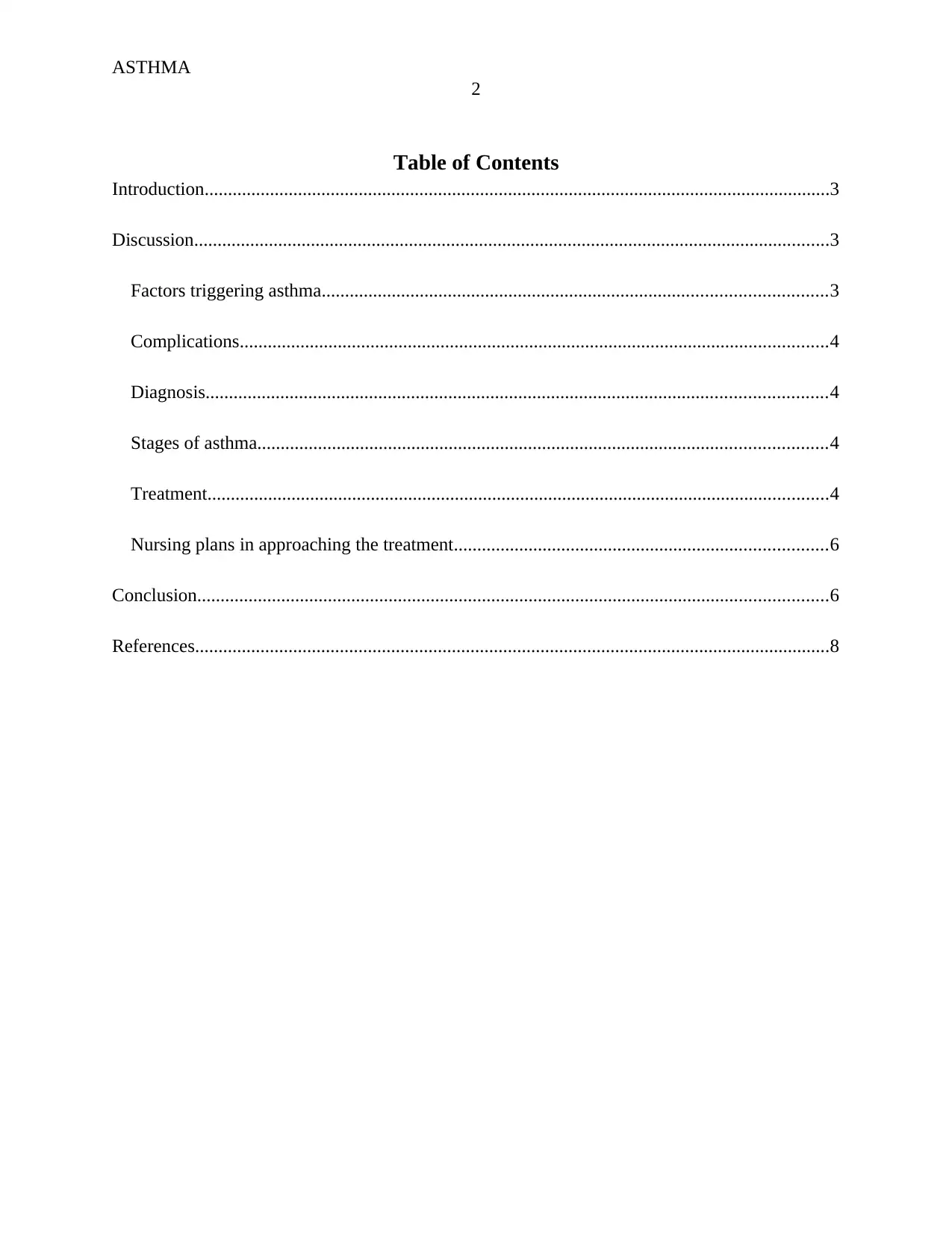
ASTHMA
2
Table of Contents
Introduction......................................................................................................................................3
Discussion........................................................................................................................................3
Factors triggering asthma............................................................................................................3
Complications..............................................................................................................................4
Diagnosis.....................................................................................................................................4
Stages of asthma..........................................................................................................................4
Treatment.....................................................................................................................................4
Nursing plans in approaching the treatment................................................................................6
Conclusion.......................................................................................................................................6
References........................................................................................................................................8
2
Table of Contents
Introduction......................................................................................................................................3
Discussion........................................................................................................................................3
Factors triggering asthma............................................................................................................3
Complications..............................................................................................................................4
Diagnosis.....................................................................................................................................4
Stages of asthma..........................................................................................................................4
Treatment.....................................................................................................................................4
Nursing plans in approaching the treatment................................................................................6
Conclusion.......................................................................................................................................6
References........................................................................................................................................8
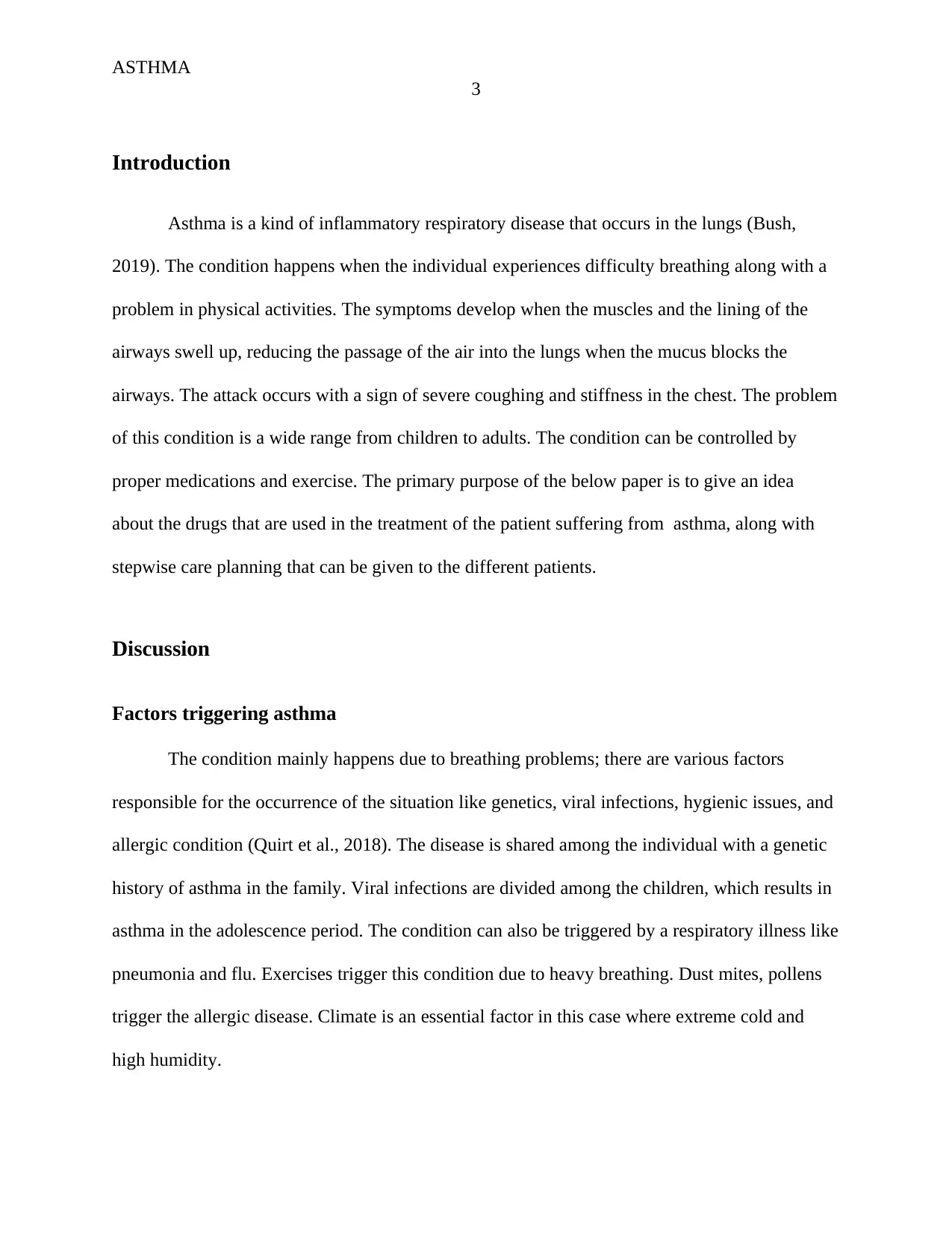
ASTHMA
3
Introduction
Asthma is a kind of inflammatory respiratory disease that occurs in the lungs (Bush,
2019). The condition happens when the individual experiences difficulty breathing along with a
problem in physical activities. The symptoms develop when the muscles and the lining of the
airways swell up, reducing the passage of the air into the lungs when the mucus blocks the
airways. The attack occurs with a sign of severe coughing and stiffness in the chest. The problem
of this condition is a wide range from children to adults. The condition can be controlled by
proper medications and exercise. The primary purpose of the below paper is to give an idea
about the drugs that are used in the treatment of the patient suffering from asthma, along with
stepwise care planning that can be given to the different patients.
Discussion
Factors triggering asthma
The condition mainly happens due to breathing problems; there are various factors
responsible for the occurrence of the situation like genetics, viral infections, hygienic issues, and
allergic condition (Quirt et al., 2018). The disease is shared among the individual with a genetic
history of asthma in the family. Viral infections are divided among the children, which results in
asthma in the adolescence period. The condition can also be triggered by a respiratory illness like
pneumonia and flu. Exercises trigger this condition due to heavy breathing. Dust mites, pollens
trigger the allergic disease. Climate is an essential factor in this case where extreme cold and
high humidity.
3
Introduction
Asthma is a kind of inflammatory respiratory disease that occurs in the lungs (Bush,
2019). The condition happens when the individual experiences difficulty breathing along with a
problem in physical activities. The symptoms develop when the muscles and the lining of the
airways swell up, reducing the passage of the air into the lungs when the mucus blocks the
airways. The attack occurs with a sign of severe coughing and stiffness in the chest. The problem
of this condition is a wide range from children to adults. The condition can be controlled by
proper medications and exercise. The primary purpose of the below paper is to give an idea
about the drugs that are used in the treatment of the patient suffering from asthma, along with
stepwise care planning that can be given to the different patients.
Discussion
Factors triggering asthma
The condition mainly happens due to breathing problems; there are various factors
responsible for the occurrence of the situation like genetics, viral infections, hygienic issues, and
allergic condition (Quirt et al., 2018). The disease is shared among the individual with a genetic
history of asthma in the family. Viral infections are divided among the children, which results in
asthma in the adolescence period. The condition can also be triggered by a respiratory illness like
pneumonia and flu. Exercises trigger this condition due to heavy breathing. Dust mites, pollens
trigger the allergic disease. Climate is an essential factor in this case where extreme cold and
high humidity.
⊘ This is a preview!⊘
Do you want full access?
Subscribe today to unlock all pages.

Trusted by 1+ million students worldwide
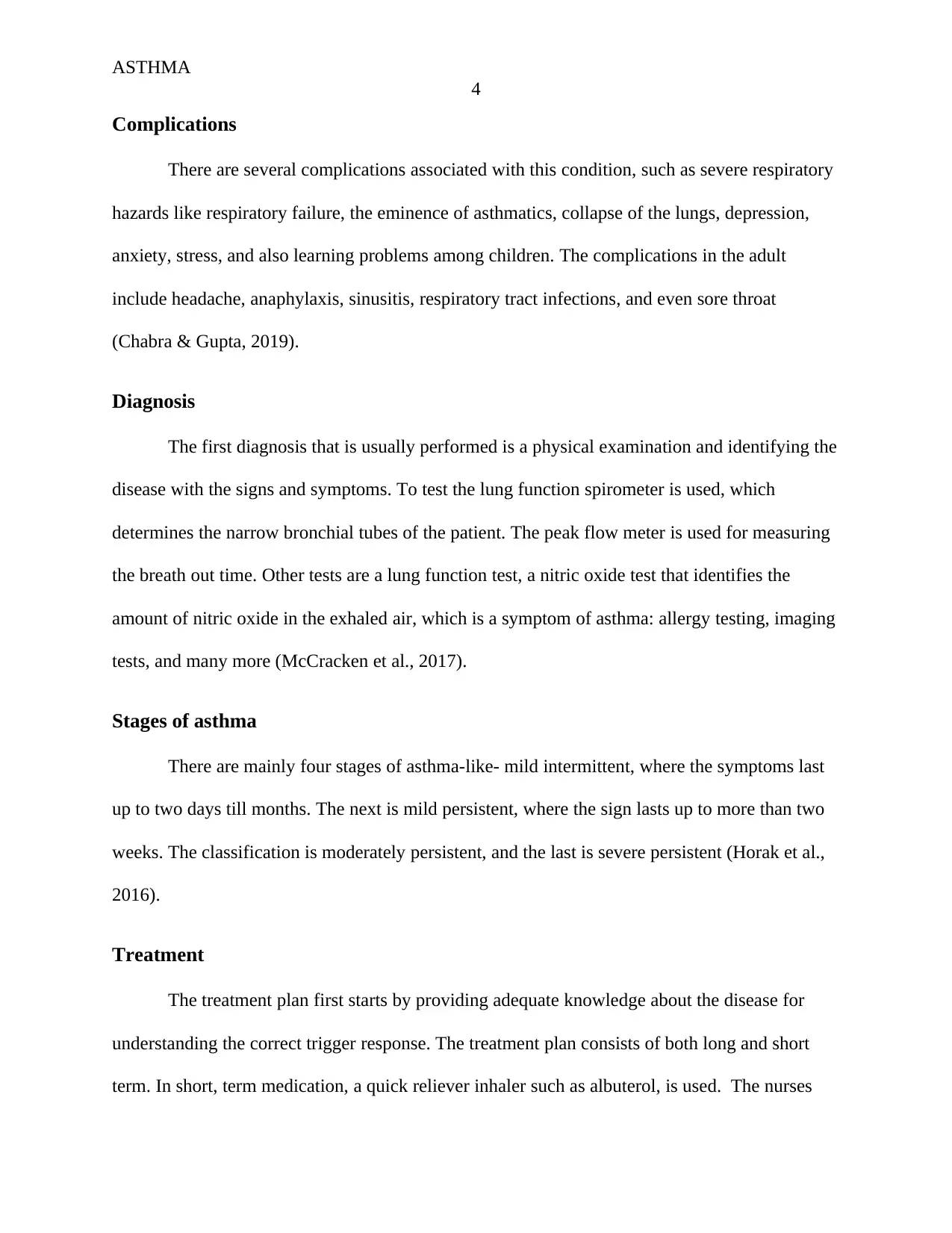
ASTHMA
4
Complications
There are several complications associated with this condition, such as severe respiratory
hazards like respiratory failure, the eminence of asthmatics, collapse of the lungs, depression,
anxiety, stress, and also learning problems among children. The complications in the adult
include headache, anaphylaxis, sinusitis, respiratory tract infections, and even sore throat
(Chabra & Gupta, 2019).
Diagnosis
The first diagnosis that is usually performed is a physical examination and identifying the
disease with the signs and symptoms. To test the lung function spirometer is used, which
determines the narrow bronchial tubes of the patient. The peak flow meter is used for measuring
the breath out time. Other tests are a lung function test, a nitric oxide test that identifies the
amount of nitric oxide in the exhaled air, which is a symptom of asthma: allergy testing, imaging
tests, and many more (McCracken et al., 2017).
Stages of asthma
There are mainly four stages of asthma-like- mild intermittent, where the symptoms last
up to two days till months. The next is mild persistent, where the sign lasts up to more than two
weeks. The classification is moderately persistent, and the last is severe persistent (Horak et al.,
2016).
Treatment
The treatment plan first starts by providing adequate knowledge about the disease for
understanding the correct trigger response. The treatment plan consists of both long and short
term. In short, term medication, a quick reliever inhaler such as albuterol, is used. The nurses
4
Complications
There are several complications associated with this condition, such as severe respiratory
hazards like respiratory failure, the eminence of asthmatics, collapse of the lungs, depression,
anxiety, stress, and also learning problems among children. The complications in the adult
include headache, anaphylaxis, sinusitis, respiratory tract infections, and even sore throat
(Chabra & Gupta, 2019).
Diagnosis
The first diagnosis that is usually performed is a physical examination and identifying the
disease with the signs and symptoms. To test the lung function spirometer is used, which
determines the narrow bronchial tubes of the patient. The peak flow meter is used for measuring
the breath out time. Other tests are a lung function test, a nitric oxide test that identifies the
amount of nitric oxide in the exhaled air, which is a symptom of asthma: allergy testing, imaging
tests, and many more (McCracken et al., 2017).
Stages of asthma
There are mainly four stages of asthma-like- mild intermittent, where the symptoms last
up to two days till months. The next is mild persistent, where the sign lasts up to more than two
weeks. The classification is moderately persistent, and the last is severe persistent (Horak et al.,
2016).
Treatment
The treatment plan first starts by providing adequate knowledge about the disease for
understanding the correct trigger response. The treatment plan consists of both long and short
term. In short, term medication, a quick reliever inhaler such as albuterol, is used. The nurses
Paraphrase This Document
Need a fresh take? Get an instant paraphrase of this document with our AI Paraphraser
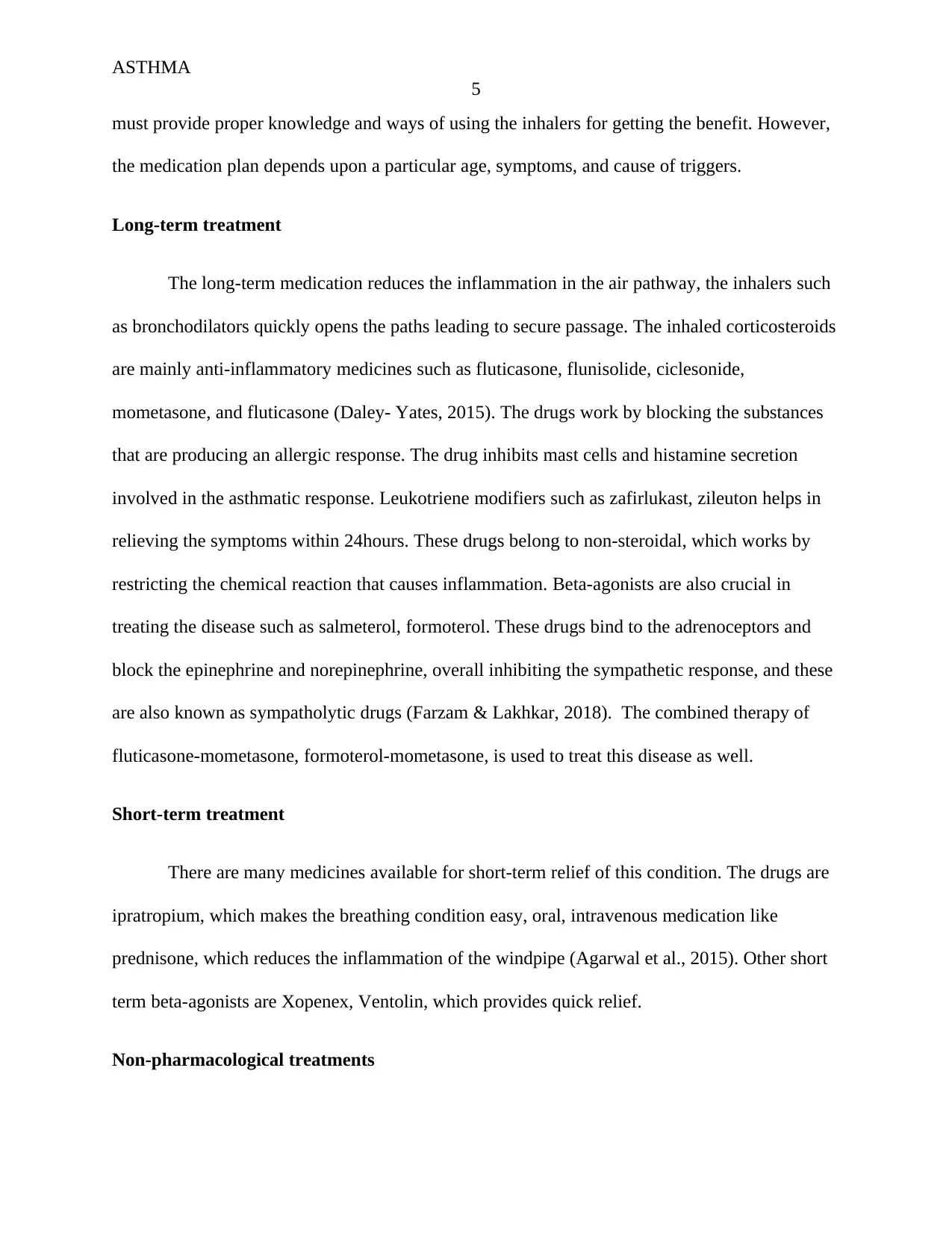
ASTHMA
5
must provide proper knowledge and ways of using the inhalers for getting the benefit. However,
the medication plan depends upon a particular age, symptoms, and cause of triggers.
Long-term treatment
The long-term medication reduces the inflammation in the air pathway, the inhalers such
as bronchodilators quickly opens the paths leading to secure passage. The inhaled corticosteroids
are mainly anti-inflammatory medicines such as fluticasone, flunisolide, ciclesonide,
mometasone, and fluticasone (Daley- Yates, 2015). The drugs work by blocking the substances
that are producing an allergic response. The drug inhibits mast cells and histamine secretion
involved in the asthmatic response. Leukotriene modifiers such as zafirlukast, zileuton helps in
relieving the symptoms within 24hours. These drugs belong to non-steroidal, which works by
restricting the chemical reaction that causes inflammation. Beta-agonists are also crucial in
treating the disease such as salmeterol, formoterol. These drugs bind to the adrenoceptors and
block the epinephrine and norepinephrine, overall inhibiting the sympathetic response, and these
are also known as sympatholytic drugs (Farzam & Lakhkar, 2018). The combined therapy of
fluticasone-mometasone, formoterol-mometasone, is used to treat this disease as well.
Short-term treatment
There are many medicines available for short-term relief of this condition. The drugs are
ipratropium, which makes the breathing condition easy, oral, intravenous medication like
prednisone, which reduces the inflammation of the windpipe (Agarwal et al., 2015). Other short
term beta-agonists are Xopenex, Ventolin, which provides quick relief.
Non-pharmacological treatments
5
must provide proper knowledge and ways of using the inhalers for getting the benefit. However,
the medication plan depends upon a particular age, symptoms, and cause of triggers.
Long-term treatment
The long-term medication reduces the inflammation in the air pathway, the inhalers such
as bronchodilators quickly opens the paths leading to secure passage. The inhaled corticosteroids
are mainly anti-inflammatory medicines such as fluticasone, flunisolide, ciclesonide,
mometasone, and fluticasone (Daley- Yates, 2015). The drugs work by blocking the substances
that are producing an allergic response. The drug inhibits mast cells and histamine secretion
involved in the asthmatic response. Leukotriene modifiers such as zafirlukast, zileuton helps in
relieving the symptoms within 24hours. These drugs belong to non-steroidal, which works by
restricting the chemical reaction that causes inflammation. Beta-agonists are also crucial in
treating the disease such as salmeterol, formoterol. These drugs bind to the adrenoceptors and
block the epinephrine and norepinephrine, overall inhibiting the sympathetic response, and these
are also known as sympatholytic drugs (Farzam & Lakhkar, 2018). The combined therapy of
fluticasone-mometasone, formoterol-mometasone, is used to treat this disease as well.
Short-term treatment
There are many medicines available for short-term relief of this condition. The drugs are
ipratropium, which makes the breathing condition easy, oral, intravenous medication like
prednisone, which reduces the inflammation of the windpipe (Agarwal et al., 2015). Other short
term beta-agonists are Xopenex, Ventolin, which provides quick relief.
Non-pharmacological treatments
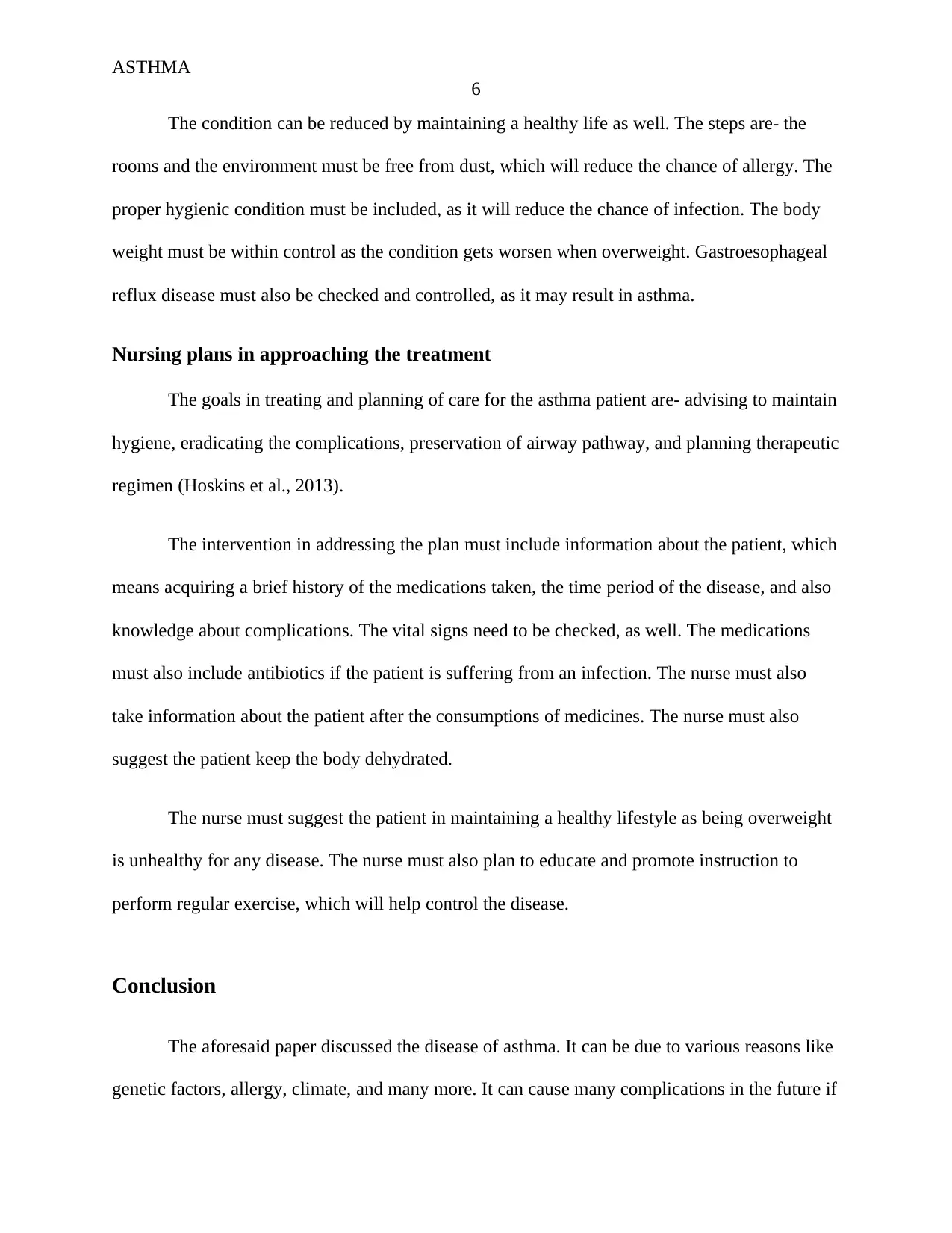
ASTHMA
6
The condition can be reduced by maintaining a healthy life as well. The steps are- the
rooms and the environment must be free from dust, which will reduce the chance of allergy. The
proper hygienic condition must be included, as it will reduce the chance of infection. The body
weight must be within control as the condition gets worsen when overweight. Gastroesophageal
reflux disease must also be checked and controlled, as it may result in asthma.
Nursing plans in approaching the treatment
The goals in treating and planning of care for the asthma patient are- advising to maintain
hygiene, eradicating the complications, preservation of airway pathway, and planning therapeutic
regimen (Hoskins et al., 2013).
The intervention in addressing the plan must include information about the patient, which
means acquiring a brief history of the medications taken, the time period of the disease, and also
knowledge about complications. The vital signs need to be checked, as well. The medications
must also include antibiotics if the patient is suffering from an infection. The nurse must also
take information about the patient after the consumptions of medicines. The nurse must also
suggest the patient keep the body dehydrated.
The nurse must suggest the patient in maintaining a healthy lifestyle as being overweight
is unhealthy for any disease. The nurse must also plan to educate and promote instruction to
perform regular exercise, which will help control the disease.
Conclusion
The aforesaid paper discussed the disease of asthma. It can be due to various reasons like
genetic factors, allergy, climate, and many more. It can cause many complications in the future if
6
The condition can be reduced by maintaining a healthy life as well. The steps are- the
rooms and the environment must be free from dust, which will reduce the chance of allergy. The
proper hygienic condition must be included, as it will reduce the chance of infection. The body
weight must be within control as the condition gets worsen when overweight. Gastroesophageal
reflux disease must also be checked and controlled, as it may result in asthma.
Nursing plans in approaching the treatment
The goals in treating and planning of care for the asthma patient are- advising to maintain
hygiene, eradicating the complications, preservation of airway pathway, and planning therapeutic
regimen (Hoskins et al., 2013).
The intervention in addressing the plan must include information about the patient, which
means acquiring a brief history of the medications taken, the time period of the disease, and also
knowledge about complications. The vital signs need to be checked, as well. The medications
must also include antibiotics if the patient is suffering from an infection. The nurse must also
take information about the patient after the consumptions of medicines. The nurse must also
suggest the patient keep the body dehydrated.
The nurse must suggest the patient in maintaining a healthy lifestyle as being overweight
is unhealthy for any disease. The nurse must also plan to educate and promote instruction to
perform regular exercise, which will help control the disease.
Conclusion
The aforesaid paper discussed the disease of asthma. It can be due to various reasons like
genetic factors, allergy, climate, and many more. It can cause many complications in the future if
⊘ This is a preview!⊘
Do you want full access?
Subscribe today to unlock all pages.

Trusted by 1+ million students worldwide
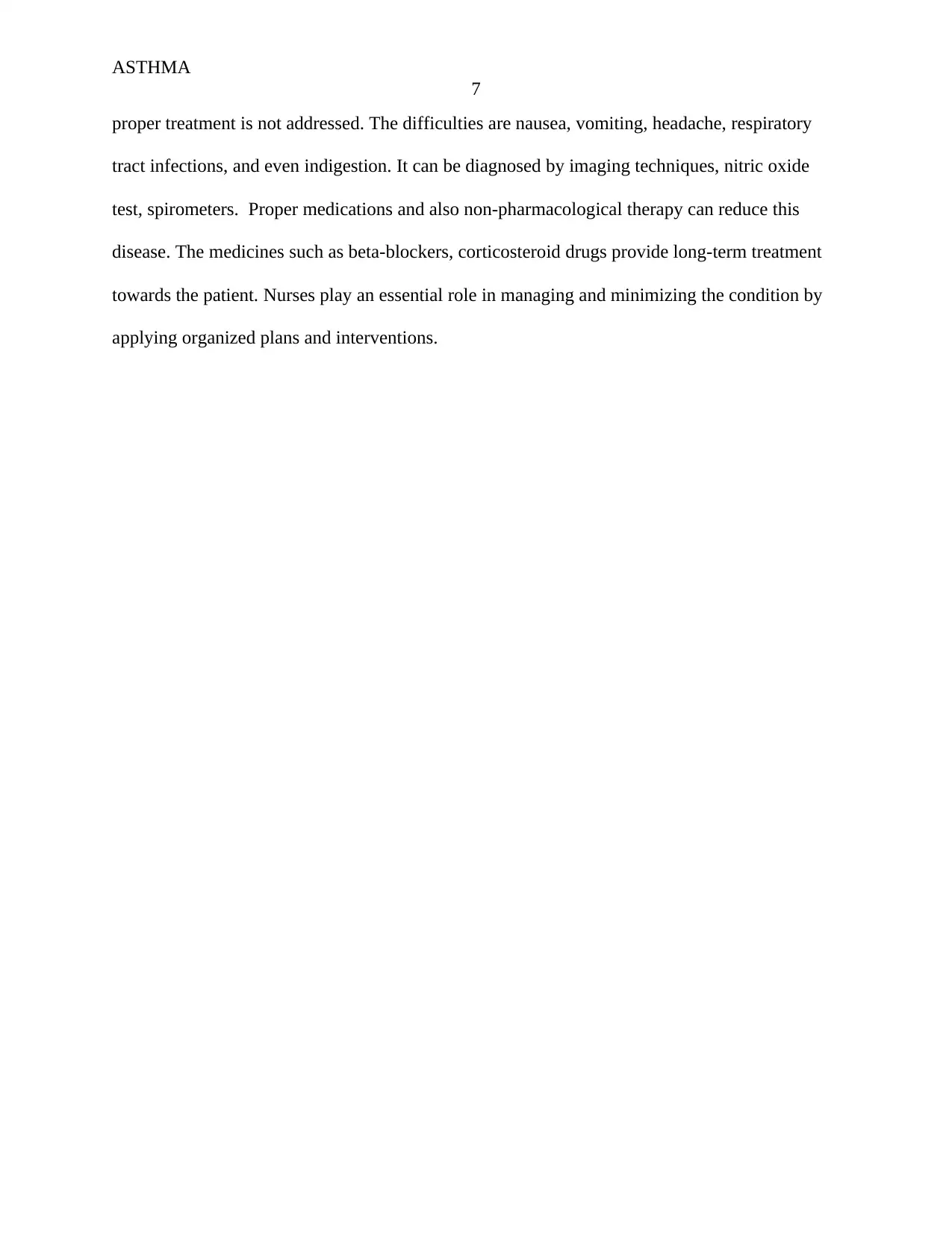
ASTHMA
7
proper treatment is not addressed. The difficulties are nausea, vomiting, headache, respiratory
tract infections, and even indigestion. It can be diagnosed by imaging techniques, nitric oxide
test, spirometers. Proper medications and also non-pharmacological therapy can reduce this
disease. The medicines such as beta-blockers, corticosteroid drugs provide long-term treatment
towards the patient. Nurses play an essential role in managing and minimizing the condition by
applying organized plans and interventions.
7
proper treatment is not addressed. The difficulties are nausea, vomiting, headache, respiratory
tract infections, and even indigestion. It can be diagnosed by imaging techniques, nitric oxide
test, spirometers. Proper medications and also non-pharmacological therapy can reduce this
disease. The medicines such as beta-blockers, corticosteroid drugs provide long-term treatment
towards the patient. Nurses play an essential role in managing and minimizing the condition by
applying organized plans and interventions.
Paraphrase This Document
Need a fresh take? Get an instant paraphrase of this document with our AI Paraphraser
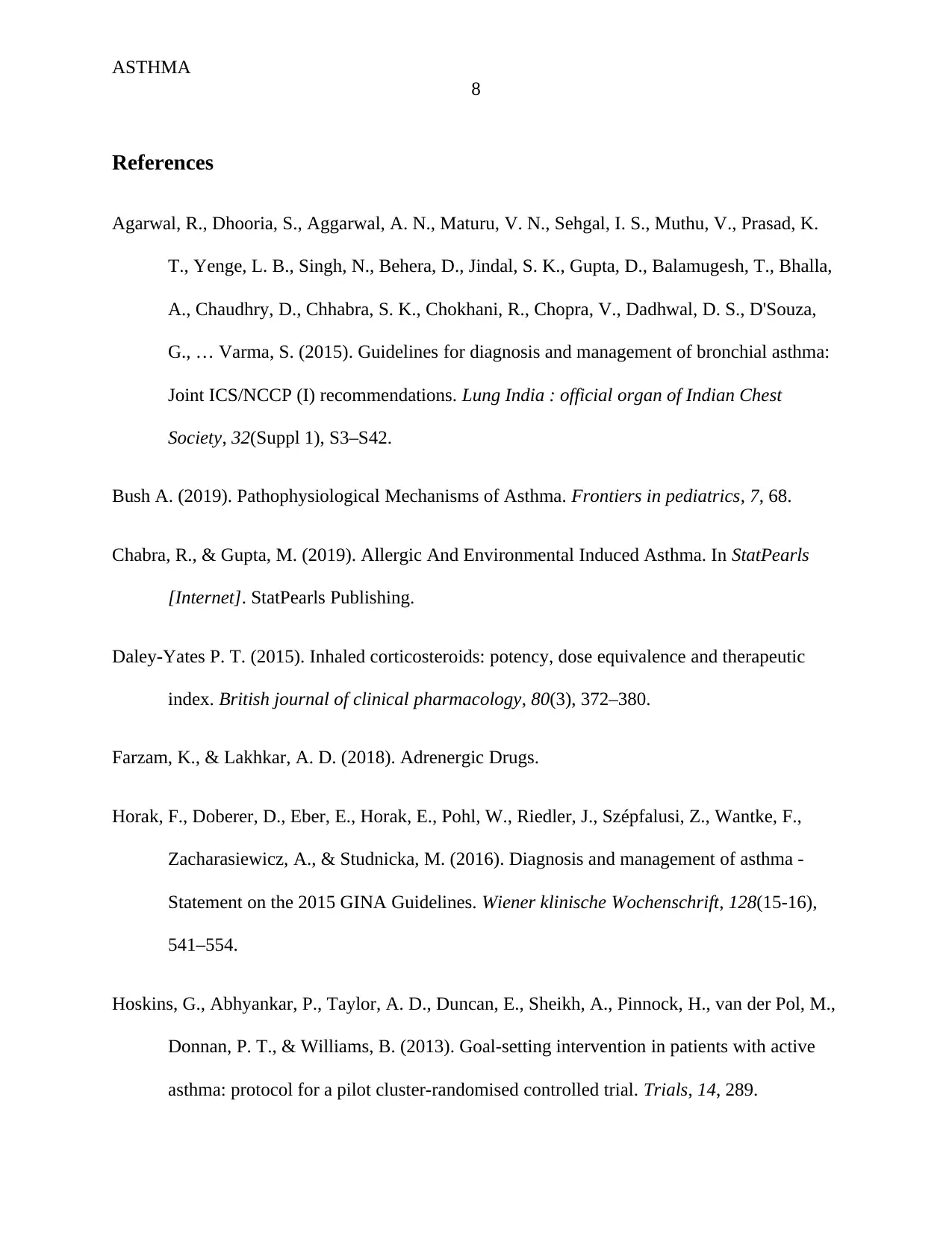
ASTHMA
8
References
Agarwal, R., Dhooria, S., Aggarwal, A. N., Maturu, V. N., Sehgal, I. S., Muthu, V., Prasad, K.
T., Yenge, L. B., Singh, N., Behera, D., Jindal, S. K., Gupta, D., Balamugesh, T., Bhalla,
A., Chaudhry, D., Chhabra, S. K., Chokhani, R., Chopra, V., Dadhwal, D. S., D'Souza,
G., … Varma, S. (2015). Guidelines for diagnosis and management of bronchial asthma:
Joint ICS/NCCP (I) recommendations. Lung India : official organ of Indian Chest
Society, 32(Suppl 1), S3–S42.
Bush A. (2019). Pathophysiological Mechanisms of Asthma. Frontiers in pediatrics, 7, 68.
Chabra, R., & Gupta, M. (2019). Allergic And Environmental Induced Asthma. In StatPearls
[Internet]. StatPearls Publishing.
Daley-Yates P. T. (2015). Inhaled corticosteroids: potency, dose equivalence and therapeutic
index. British journal of clinical pharmacology, 80(3), 372–380.
Farzam, K., & Lakhkar, A. D. (2018). Adrenergic Drugs.
Horak, F., Doberer, D., Eber, E., Horak, E., Pohl, W., Riedler, J., Szépfalusi, Z., Wantke, F.,
Zacharasiewicz, A., & Studnicka, M. (2016). Diagnosis and management of asthma -
Statement on the 2015 GINA Guidelines. Wiener klinische Wochenschrift, 128(15-16),
541–554.
Hoskins, G., Abhyankar, P., Taylor, A. D., Duncan, E., Sheikh, A., Pinnock, H., van der Pol, M.,
Donnan, P. T., & Williams, B. (2013). Goal-setting intervention in patients with active
asthma: protocol for a pilot cluster-randomised controlled trial. Trials, 14, 289.
8
References
Agarwal, R., Dhooria, S., Aggarwal, A. N., Maturu, V. N., Sehgal, I. S., Muthu, V., Prasad, K.
T., Yenge, L. B., Singh, N., Behera, D., Jindal, S. K., Gupta, D., Balamugesh, T., Bhalla,
A., Chaudhry, D., Chhabra, S. K., Chokhani, R., Chopra, V., Dadhwal, D. S., D'Souza,
G., … Varma, S. (2015). Guidelines for diagnosis and management of bronchial asthma:
Joint ICS/NCCP (I) recommendations. Lung India : official organ of Indian Chest
Society, 32(Suppl 1), S3–S42.
Bush A. (2019). Pathophysiological Mechanisms of Asthma. Frontiers in pediatrics, 7, 68.
Chabra, R., & Gupta, M. (2019). Allergic And Environmental Induced Asthma. In StatPearls
[Internet]. StatPearls Publishing.
Daley-Yates P. T. (2015). Inhaled corticosteroids: potency, dose equivalence and therapeutic
index. British journal of clinical pharmacology, 80(3), 372–380.
Farzam, K., & Lakhkar, A. D. (2018). Adrenergic Drugs.
Horak, F., Doberer, D., Eber, E., Horak, E., Pohl, W., Riedler, J., Szépfalusi, Z., Wantke, F.,
Zacharasiewicz, A., & Studnicka, M. (2016). Diagnosis and management of asthma -
Statement on the 2015 GINA Guidelines. Wiener klinische Wochenschrift, 128(15-16),
541–554.
Hoskins, G., Abhyankar, P., Taylor, A. D., Duncan, E., Sheikh, A., Pinnock, H., van der Pol, M.,
Donnan, P. T., & Williams, B. (2013). Goal-setting intervention in patients with active
asthma: protocol for a pilot cluster-randomised controlled trial. Trials, 14, 289.
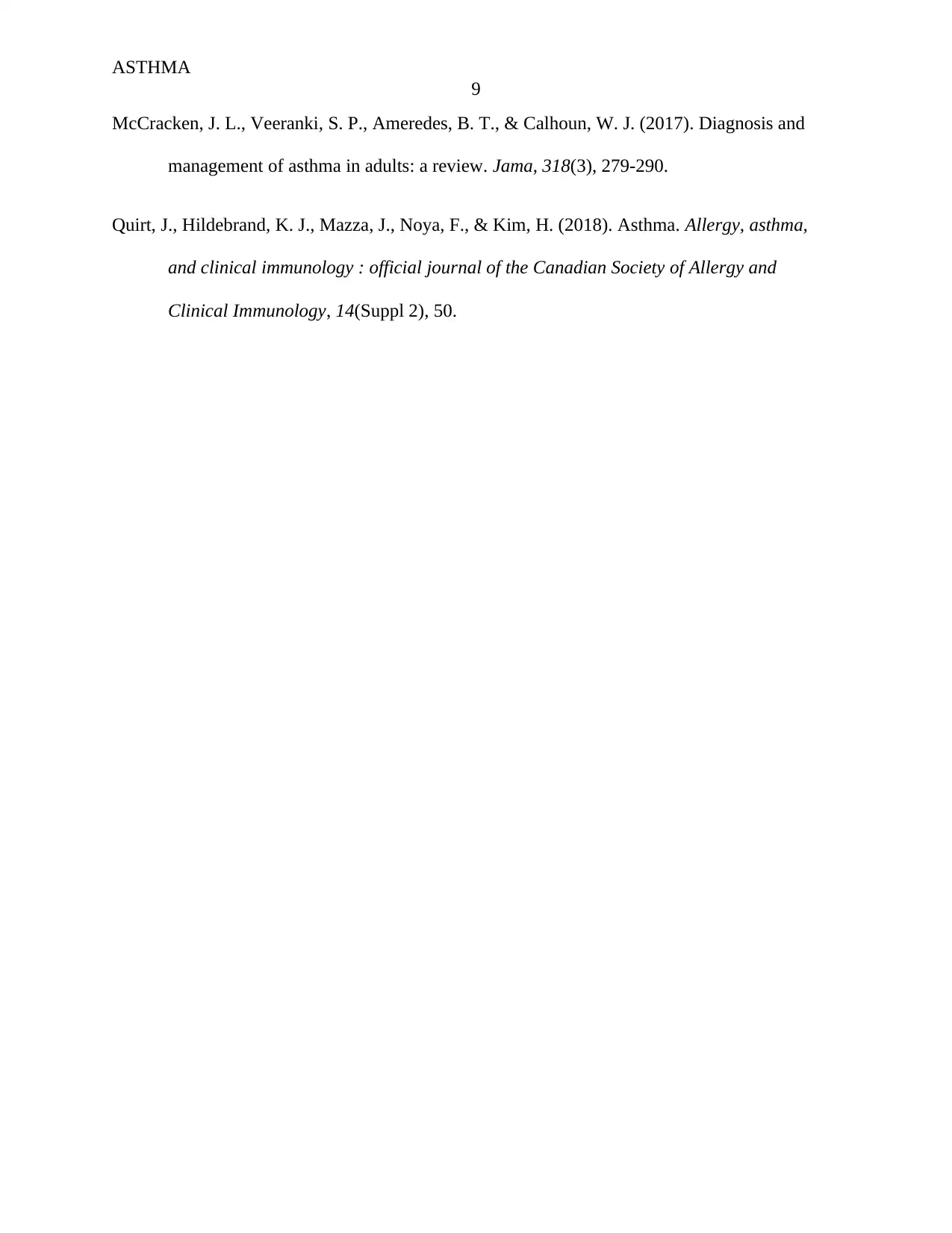
ASTHMA
9
McCracken, J. L., Veeranki, S. P., Ameredes, B. T., & Calhoun, W. J. (2017). Diagnosis and
management of asthma in adults: a review. Jama, 318(3), 279-290.
Quirt, J., Hildebrand, K. J., Mazza, J., Noya, F., & Kim, H. (2018). Asthma. Allergy, asthma,
and clinical immunology : official journal of the Canadian Society of Allergy and
Clinical Immunology, 14(Suppl 2), 50.
9
McCracken, J. L., Veeranki, S. P., Ameredes, B. T., & Calhoun, W. J. (2017). Diagnosis and
management of asthma in adults: a review. Jama, 318(3), 279-290.
Quirt, J., Hildebrand, K. J., Mazza, J., Noya, F., & Kim, H. (2018). Asthma. Allergy, asthma,
and clinical immunology : official journal of the Canadian Society of Allergy and
Clinical Immunology, 14(Suppl 2), 50.
⊘ This is a preview!⊘
Do you want full access?
Subscribe today to unlock all pages.

Trusted by 1+ million students worldwide
1 out of 9
Related Documents
Your All-in-One AI-Powered Toolkit for Academic Success.
+13062052269
info@desklib.com
Available 24*7 on WhatsApp / Email
![[object Object]](/_next/static/media/star-bottom.7253800d.svg)
Unlock your academic potential
Copyright © 2020–2025 A2Z Services. All Rights Reserved. Developed and managed by ZUCOL.



